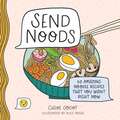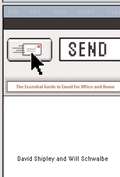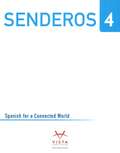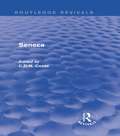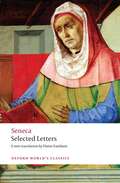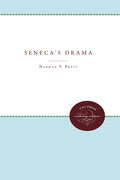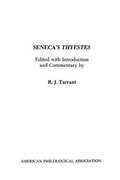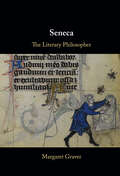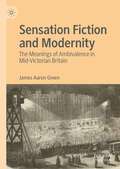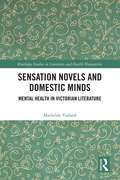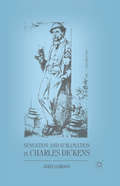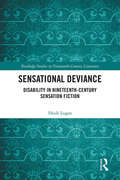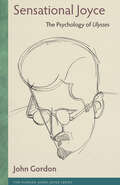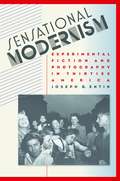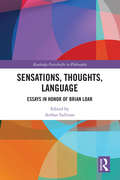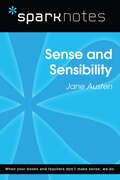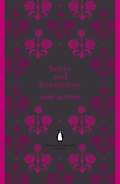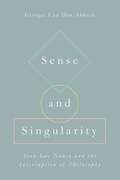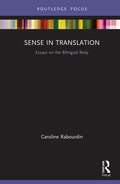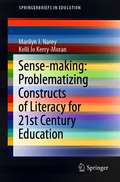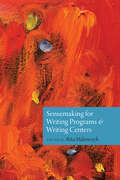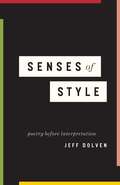- Table View
- List View
Send Noods: 50 Amazing Noodle Recipes That You Want Right Now
by Chloe GodotGet the noods you really want!Things are looking hot with Send Noods, a cleverly tantalizing book of 50 noodle recipes that will never fail to whet your appetite.When your actual DMs are just too cringeworthy and you’d rather have a bowl of ramen to keep you warm at night, turn to the cookbook that really satisfies. Each chapter is organized to help you find your perfect match, from Chapter One: The Little Black Book of Basics, which steers you toward every good ol’ base sauce and broth you’ll ever need, to Chapter Two: Heart Warmers, that always deliver on their comfort-food promises, to Chapter Five: The Hotties, that leave you hungry for more. Go ahead and ogle the piping-hot illustrations of your deepest cravings, including:- F*&#boy Fettuccini- Red Flag Red Sauce- Looking Fresh Pesto- How You Doin’ Homemade Italian Sausage- U Up? Udon- Sex Is Cool, But Have You Tried My Pho?- Swipe Right Ramen- Slide into My DMs Strozzapreti- Mack on This Mac ‘n’ Cheese- Dreamboat ArrabiataComplete with playful illustrations and explicit instructions that make each recipe’s intentions known, Chloe Godot and Alice Potter's Send Noods is the book of hot dishes that will satisfy epicureans in ways unsolicited DMs just never could.
Send: The Essential Guide to Email for Office and Home
by David Shipley Will SchwalbeThe hows and whys of using email, and how to communicate effectively.
Senderos Level 4 Spanish for a Connected World
by Vista Higher LearningSenderos Level 4 Spanish for a Connected World
Seneca (Routledge Revivals)
by Costa C.D.N.This volume, first published in 1974, offers a selection of modern perspectives on Seneca, covering his prose treatises, his letters and his tragedies. For centuries literary and philosophical circles had to take Seneca seriously, even if they could not always respect him, and although his reputation has fluctuated, there has been a revival of interest in his achievements. Accordingly, a large part of Seneca is devoted to this later influence at the deliberate expense of not covering all of Seneca’s less familiar works. The Moral Essays, the tragedies and the letters to Lucilius are examined by the contributors, who also discuss Seneca’s philosophical influence and the Senecan heritage in English and neo-Latin literature. Each essay contains insightful and sometimes controversial material, which is of value to the specialist as well as to students of Latin, English or French literature.
Seneca Selected Letters (Oxford World's Classics)
by Elaine Fantham Seneca Corporation StaffWe often speak of Seneca as the most distinguished of the many Spanish writers and poets of Rome's imperial age, starting from his own father of the same name, and his nephew Lucan, and including Columella, Martial, and Quintilian. But although all of these writers came from Spain, they were Roman (or Italian) in descent, culture, and tradition. Scipio Africanus had taken eastern and southern Spain from the Carthaginians during the Hannibalic war, and most of the Spanish peninsula had been Roman since the second century BCE.
Seneca's Drama
by Norman T. PrattWith insight and clarity, Norman Pratt makes available to the general reader an understanding of the major elements that shaped Seneca's plays. These he defines as Neo-Stoicism, declamatory rhetoric, and the chaotic, violent conditions of Senecan society.Seneca's drama shows the nature of this society and uses freely the declamatory rhetorical techniques familiar to any well-educated Roman. But the most important element, Pratt argues, is Neo-Stoicism, including technical aspects of this philosophy that previously have escaped notice. With these ingredients Seneca transformed the themes and characters inherited from Greek drama, casting them in a form that so radically departs from the earlier drama that Seneca's plays require a different mode of criticism."The greatest need in the criticism of this drama is to understand its legitimacy as drama of a new kind in the anicent tradition," Pratt writes. "It cannot be explained as an inferior imitation of Greek tragedy because, though inferior, it is not imitative in the strict sense of the word and has its own nature and motivation."Pratt shows the functional interrelationship among philosophy, rhetoric, and "society" in Seneca's nine plays and assesses the plays' dramatic qualities. He finds that however melodramatic the plays may seem to the modern reader, Seneca's own career as Nero's mentor, statesman, and spokesman was scarcely less tumultuous than the lives of his characters. When the Neo-Stoicism and rhetoric of the plays are charged with Seneca's own tortured, passionate life, Pratt concludes, "The result is inevitably melodrama, melodrama of such energy and force that it changed the course of Western drama."Originally published in 1983.A UNC Press Enduring Edition -- UNC Press Enduring Editions use the latest in digital technology to make available again books from our distinguished backlist that were previously out of print. These editions are published unaltered from the original, and are presented in affordable paperback formats, bringing readers both historical and cultural value.
Seneca's Thyestes
by Lucius Annaeus Seneca R. J. TarrantThyestes is widely acknowledged to be one of Seneca's most powerful tragedies. The book provides a modern commentary on the play.
Senhora
by José De AlencarA critique of marriage of convenience, this classic of Brazilian literature clarifies universal truths as one-time lovers reconcile as husband and wife. The poor orphan Aurélia is devastated when her true love, Fernando, breaks their engagement for the financial rewards of a marriage of convenience to another. But Aurélia unexpectedly inherits a fortune and plans her revenge. Winning marriage to Fernando with a large dowery, she stuns her lover on their wedding night by imposing a marriage of convenience until the dowery is returned. The marriage descends into one of hate more than convenience, until both recognize the errors of their ways.
Sensation Fiction and Modernity: The Meanings of Ambivalence in Mid-Victorian Britain
by James Aaron GreenThis book re-reads the relationship between the Victorian sensation novel and modernity. Whereas critics have long recognized its appearance in the form of nervous subjects and technologically-enabled mobility, Green contends that sensation fiction also depicts modernity in the form of intellectual and moral discontinuity. Through closely historicist readings of novels by Wilkie Collins and Mary Elizabeth Braddon, as well as by Joseph Sheridan Le Fanu and Rhoda Broughton, this book traces how discontinuity is manifested in the suspenseful plotting of these fictions, through which readers are challenged to revise conventional assumptions about the world and adopt more contingent perspectives. The study demonstrates that reading for this sense of modernity does not merely uncover the genre's engagements with various mid-century contexts. More fundamentally, it broaches a new sense of the function and significance of sensation fiction: the acclimatization of its readers to the discontinuities of modern existence.
Sensation Novels and Domestic Minds: Mental Health in Victorian Literature (Routledge Studies in Literature and Health Humanities)
by Mathilde VialardDrawing on the recent academic interest in approaching health and wellbeing from a humanities perspective, Sensation Novels and Domestic Minds investigates how the Victorians dealt with questions of mental health by examining literary works in the genre of sensation fiction. The novels of Mary Elizabeth Braddon and Wilkie Collins, two prominent writers of the genre, often portray characters suffering from mental illnesses commonly diagnosed at the time, among which are monomania, moral insanity, melancholia and hypochondria. By studying the fictional works of Braddon and Collins alongside medical texts from the nineteenth century, it sets out to investigate how these novels fictionally represented real mental sufferings. This book considers the different mental illnesses the characters of sensation novels develop inside and outside the home as they struggle to define their own identity against Victorian social expectations. It demonstrates how these novels fictionalised the crisis of the leisured upper classes, who spent most of their time at home, and found themselves at odds with a society that increasingly separated the domestic and working environments, while also considering the impact that a lack of a sense of domestic belonging could have on their mental health. Sensation Novels and Domestic Minds further analyses the extent to which domesticity—in its excess or lack—could afflict the mental health of Victorian men and women through the fictional representation of suicidal thoughts and acts in the novels of Braddon and Collins.
Sensation and Sublimation in Charles Dickens
by John GordonThis book explores three crucial stages in Dickens' on-going voyage of discovery into what has been called the 'hidden springs' of his fiction; arguing that in three of Dickens best known novels, we witness Dickens responding to some identifiable force represented as coming from underneath the ground plan of the book in question.
Sensational Deviance: Disability in Nineteenth-Century Sensation Fiction (Routledge Studies in Nineteenth Century Literature)
by Heidi LoganSensational Deviance: Disability in Nineteenth-Century Sensation Fiction investigates the representation of disability in fictional works by the leading Victorian sensation novelists Wilkie Collins and Mary Elizabeth Braddon, exploring how disability acts as a major element in the shaping of the sensation novel genre and how various sensation novels respond to traditional viewpoints of disability and to new developments in physiological and psychiatric knowledge. The depictions of disabled characters in sensation fiction frequently deviate strongly from typical depictions of disability in mainstream Victorian literature, undermining its stigmatized positioning as tragic deficit, severe limitation, or pathology. Close readings of nine individual novels situate their investigations of physical, sensory, and cognitive disabilities against the period’s disability discourses and interest in senses, perception, stimuli, the nervous system, and the hereditability of impairments. The importance of moral insanity and degeneration theory within sensation fiction connect the genre with criminal anthropology, suggesting the genre’s further significance in the light of the later emergence of eugenics, psychoanalysis, and genetics.
Sensational Joyce: The Psychology of Ulysses (The Florida James Joyce Series)
by John GordonExploring how Ulysses imitates the human mind at work, connecting close readings to psychological theories of Joyce’s time In this book, John Gordon uses historically oriented close readings to demonstrate that Ulysses is a book that mimics the workings of the human mind. Gordon highlights James Joyce’s exceptional ability to capture and represent lived experiences, showing how Joyce’s writings display the ways specific minds interact with their environments. Ulysses is portrayed here as having its own evolving consciousness. Sensational Joyce is the first book on Joyce’s psychology to engage deeply with theorists beyond Freud, Jung, or Lacan. Gordon explains how Joyce used other psychological theories, like William James’s ideas on stimulus and response, Gestalt psychology, John Watson’s behaviorism, and trauma research. The book also includes discussions of phenomena considered experimental at the time, such as telepathy, telekinesis, precognition, and spiritualism. Gordon examines the characters of sensitive intellectual Stephen Dedalus and advertising professional Leopold Bloom, following the book’s centers of consciousness into the visionary, hallucinatory, and prophetic final chapters. Gordon highlights how Joyce’s unique writing style transforms sensations and stimuli into thoughts and responses. As Ulysses progresses, the sensational—meaning sensory data—becomes sensationalistic. In tracing the contemporary theories of psychology evidenced in the novel, Sensational Joyce presents many new and original interpretations that can be applied to other works by Joyce, especially Finnegans Wake. A volume in the Florida James Joyce Series, edited by Sam Slote
Sensational Modernism
by Joseph B. EntinChallenging the conventional wisdom that the 1930s were dominated by literary and photographic realism, Sensational Modernism uncovers a rich vein of experimental work by politically progressive artists. Examining images by photographers such as Weegee and Aaron Siskind and fiction by writers such as William Carlos Williams, Richard Wright, Tillie Olsen, and Pietro di Donato, Joseph Entin argues that these artists drew attention to the country's most vulnerable residents by using what he calls an "aesthetic of astonishment," focused on startling, graphic images of pain, injury, and prejudice. Traditional portrayals of the poor depicted stoic, passive figures of sentimental suffering or degraded but potentially threatening figures in need of supervision. Sensational modernists sought to shock middle-class audiences into new ways of seeing the nation's impoverished and outcast populations. The striking images these artists created, often taking the form of contorted or disfigured bodies drawn from the realm of the tabloids, pulp magazines, and cinema, represented a bold, experimental form of social aesthetics. Entin argues that these artists created a willfully unorthodox brand of vernacular modernism in which formal avant-garde innovations were used to delineate the conditions, contradictions, and pressures of life on the nation's fringes.
Sensations, Thoughts, Language: Essays in Honour of Brian Loar (Routledge Festschrifts in Philosophy)
by Arthur SullivanBrian Loar (1939-2014) was an eminent and highly respected philosopher of mind and language. He was at the forefront of several different field-defining debates between the 1970s and the 2000s—from his earliest work on reducing semantics to psychology, through debates about reference, functionalism, externalism, and the nature of intentionality, to his most enduringly influential work on the explanatory gap between consciousness and neurons. Loar is widely credited with having developed the most comprehensive functionalist account of certain aspects of the mind, and his ‘phenomenal content strategy’ is arguably one of the most significant developments on the ancient mind/body problem. This volume of essays honours the entirety of Loar’s wide-ranging philosophical career. It features sixteen original essays from influential figures in the fields of philosophy of language and philosophy of mind, including those who worked with and were taught by Loar. The essays are divided into three thematic sections covering Loar’s work in philosophy of language, especially the relations between semantics and psychology (1970s-80s), on content in the philosophy of mind (1980s-90s), and on the metaphysics of intentionality and consciousness (1990s and beyond). Taken together, this book is a fitting tribute to one of the leading minds of the latter-20th century, and a timely reflection on Loar’s enduring influence on the philosophy of mind and language.
Sense and Nonsense: A Study in Human Communication
by Alfred FleishmanA book on semantics and how to improve general communication.
Sense and Nonsensibility
by Lawrence Douglas Alexander GeorgeTwo widely published humor columnists and "bad boys" of academia take their wit and wisdom to dazzling new lows in this irreverent send-up of highbrow literary culture. At last, the thinking person's take on the life of the mind in today's increasingly mindless age. Sense and Nonsensibility pokes fun at everyone from spoof-proof scholars to pompous professors; from anal-retentive authors to plagiarizing poets; from snake-oil therapists to bestselling illiterati. This singular collection by Professors Lawrence Douglas and Alexander George brings together their most popular pieces, along with many brand-new ones, including: The Academy Awards for novels -- with categories for "Best Female Protagonist -- Doomed," "Best Narrator -- Unreliable," and "Best Novel -- Unfinishable by Reader" Home Shopping University -- offering the greatest ideas in Western history at rock-bottom prices I'm Okay, I'm Okay: Accepting Narcissism -- the best in "Self-helplessness books" The Penis Orations -- Iron Man's answer to The Vagina Monologues "Ask the Academic Ethicist" -- their notorious advice column, which has shocked higher education
Sense and Sensibility (SparkNotes Literature Guide Series)
by SparkNotesSense and Sensibility (SparkNotes Literature Guide) by Jane Austen Making the reading experience fun! Created by Harvard students for students everywhere, SparkNotes is a new breed of study guide: smarter, better, faster. Geared to what today's students need to know, SparkNotes provides: *Chapter-by-chapter analysis *Explanations of key themes, motifs, and symbols *A review quiz and essay topicsLively and accessible, these guides are perfect for late-night studying and writing papers
Sense and Sensibility (The Penguin English Library)
by Jane Austen"The more I know of the world, the more am I convinced that I shall never see a man whom I can really love. I require so much!"Jane Austen's novel tells the story of Marianne Dashwood, who wears her heart on her sleeve, and when she falls in love with the dashing but unsuitable John Willoughby she ignores her sister Elinor's warning that her impulsive behaviour leaves her open to gossip and innuendo. Meanwhile Elinor, always sensitive to social convention, is struggling to conceal her own romantic disappointment, even from those closest to her. Through their parallel experience of love - and its threatened loss - the sisters learn that sense must mix with sensibility if they are to find personal happiness in a society where status and money govern the rules of love.The Penguin English Library - 100 editions of the best fiction in English, from the eighteenth century and the very first novels to the beginning of the First World War.
Sense and Singularity: Jean-Luc Nancy and the Interruption of Philosophy
by Georges Van Den AbbeelePhilosophical thinking is interrupted by the finitude of what cannot be named, on the one hand, and that within which it is subsumed as one of multiple modes of sense-making, on the other. Sense and Singularity elaborates Jean-Luc Nancy’s philosophical project as an inquiry into the limits or finitude of philosophy itself, where it is interrupted, and as a practice of critical intervention where philosophy serves to interrupt otherwise unquestioned ways of thinking. Nancy’s interruption of philosophy, Van Den Abbeele argues, reveals the limits of what philosophy is and what it can do, its apocalyptic end and its endless renewal, its Sisyphean interruption between the bounds of infinitely replicating sense and the conceptual vanishing point that is singularity. In examinations of Nancy’s foundational rereading of Descartes's cogito as iterative, his formal experimentations with the genres of philosophical writing, the account of “retreat” in understanding the political, and the interruptive play of sense and singularity in writings on the body, sexuality, and aesthetics, Van Den Abbeele offers a fresh account of one of our major thinkers as well as a provocative inquiry into what philosophy can do.
Sense in Translation: Essays on the Bilingual Body (Routledge Advances in Translation and Interpreting Studies)
by Caroline RabourdinThis innovative and interdisciplinary work brings together six essays which explore the complex relationship between linguistic translation and spatial translation and argue for an understanding of linguistic translation as an embodied phenomenon. Integrating perspectives from philosophy, multilingual poetry and literature, as well as science and geometry, the book begins with a reading of translators Donald A. Landes’ and Richard Howard’s own notes on the translation and interpretation of the French words sens and langue. In the essays that follow, Rabourdin intertwines insights from both phenomenology and translation studies, engaging in notions of space, body, sense, and language as filtered through a multilingual lens and drawing on a diversity of sources, including work from such figures as Jacques Derrida, Maurice Merleau-Ponty, Henri Poincaré, Michel Butor, Caroline Bergvall, Jean-Jacques Lecercle, Louis Wolfson and Lisa Robertson. This interdisciplinary thematic perspective highlights the need for an understanding of the experience of translation as neither distinctly linguistic or spatial but one which fluidly allows for the bilingual body to sense and make sense. This book offers a unique contribution to translation studies, comparative literature, French studies, and philosophy of language and will be of particular interest to students and scholars in these fields.
Sense-making: Problematizing Constructs of Literacy for 21st Century Education (SpringerBriefs in Education)
by Marilyn J. Narey Kelli Jo Kerry-MoranThis book is a rich, yet highly accessible volume that details an exciting and much-needed inquiry into the notion of literacy: what it is, why it is, and how it might be framed most effectively for 21st century education. The chapters unfold in a creative interplay of practice and theory. Narey’s insightful questioning into the socio-historical-cultural implications of “literacy as empowerment” establishes the critical context, while Kerry-Moran’s examination of the burgeoning literacy landscape reveals challenges for teacher education. Drawing upon classic and cutting-edge theories, Narey builds a provocative and powerful case for a 21st century construct of literacy as sense-making: sense as relative to the senses (i.e., sight, hearing) and sense as making meaning. Her innovative model of the literacy event opens up a range of potential foci for analysis and facilitates her teasing out of two critical areas for instruction: sensory perception and aesthetic knowledge. This theoretical sense-making lens is applied to Kerry-Moran’s teacher education classroom as the authors reflect upon further development. As a timely original and thought-provoking work, this slim volume of big ideas promises to be a valuable resource for teacher educators and other scholars who seek a clear and cohesive frame for literacy in 21st century education. This is a very well written scholarly text that provides a new and important theory of 21st century literacy. Narey’s sketches of literacy as sense-making are laid out in logical form, building upon researched and referenced sources to ground her ideas and offering the reader information, examples and new insights. In addition to providing many significant perspectives underpinning her new theory, Narey provides excellent historical and current explanations about literacy from highly respected researchers in the field. The inclusion of a practical application of Narey’s conceptual/theoretical framework to Kerry-Moran's example of an instructional unit in a teacher education course is helpful to understanding the theory in practice. The references throughout the work are extensive, comprehensive and very well documented. This text, Sense-making: Problematizing Constructs of Literacy for 21st Century Education, contributes original thinking to the field of literacy and learning and would be an excellent resource for literacy and language professors or instructors in a post-graduate or professional development program.Penny Silvers, Professor of Education, Dominican University, USA
Sensemaking for Writing Programs and Writing Centers
by Rita MalenczykIn this collection writing program and writing center administrators from a range of academic institutions come together to explore their work through the lens of sensemaking. Sensemaking is an organizational theory concept that enables institutions, supervisors, teachers, tutors, and others to better understand the work they do by using narrative, metaphor, and other theoretical lenses. The book is divided into two sections: Sensemaking with Tutors and Teachers, and Sensemaking and Institutional Structures. Chapter authors employ several theoretical approaches to sensemaking, ranging from individual experience to institutional history to document design, providing readers with ideas for how to administer and teach within their programs more effectively; how to advocate for their programs within larger university contexts; and how to positively influence the lives and careers of those they work with. Sensemaking for Writing Programs and Writing Centers theorizes daily experiences from working lives and suggests problem-solving strategies. Writing program administrators, writing department chairs, and writing center directors, tutors, and staff will find value in its pages.
Senses of Style: Poetry before Interpretation
by Jeff DolvenIn an age of interpretation, style eludes criticism. Yet it does so much tacit work: telling time, telling us apart, telling us who we are. What does style have to do with form, history, meaning, our moment’s favored categories? What do we miss when we look right through it? Senses of Style essays an answer. An experiment in criticism, crossing four hundred years and composed of nearly four hundred brief, aphoristic remarks, it is a book of theory steeped in examples, drawn from the works and lives of two men: Sir Thomas Wyatt, poet and diplomat in the court of Henry VIII, and his admirer Frank O’Hara, the midcentury American poet, curator, and boulevardier. Starting with puzzle of why Wyatt’s work spoke so powerfully to O’Hara across the centuries, Jeff Dolven ultimately explains what we talk about when we talk about style, whether in the sixteenth century, the twentieth, or the twenty-first.
